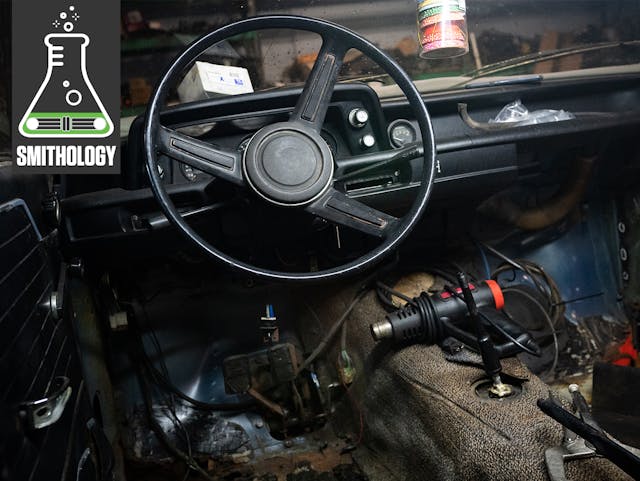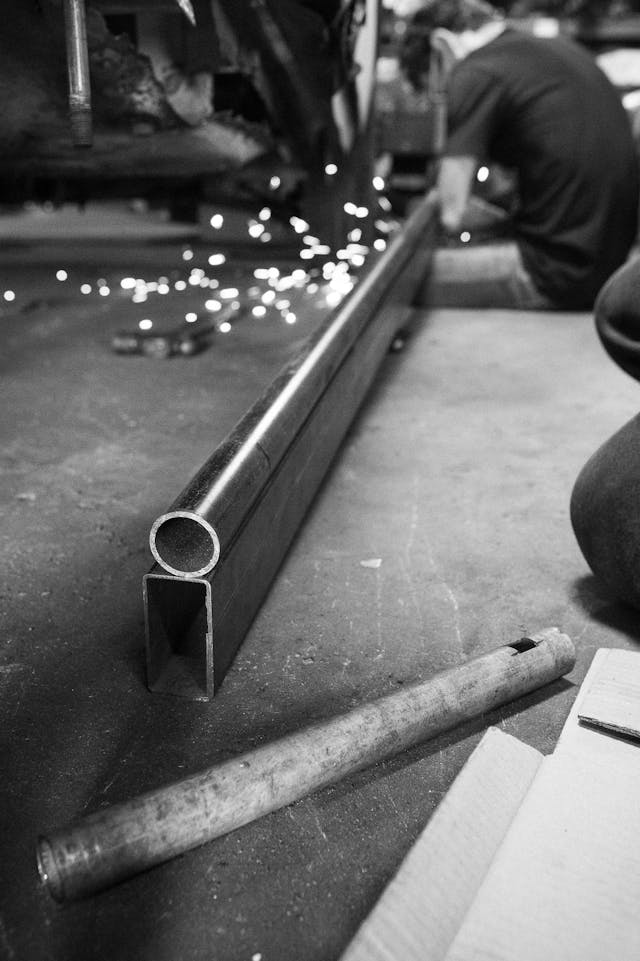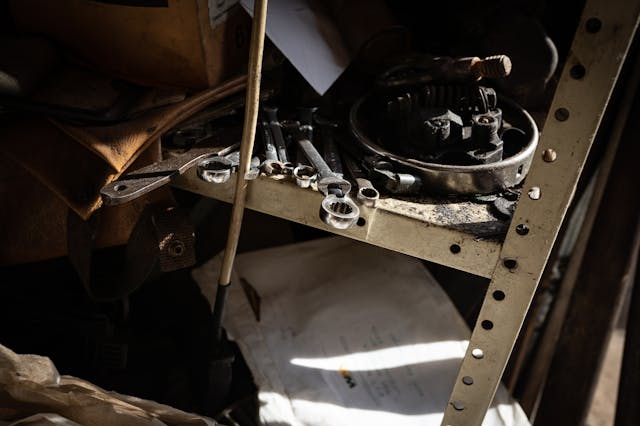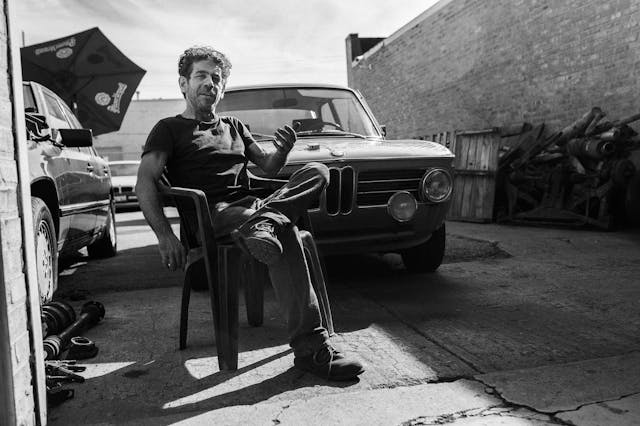Media | Articles
Smithology: This thing cannot get any worse

Welcome back to The Weissrat Chronicles, Sam Smith’s tale of dragging an $1800 BMW 2002tii back to life in off-hours and weekends, when he’s not busy testing new cars for Hagerty. This is the fourth installment in the series, with the chapters best enjoyed in order: One, Two, Three, Four, Five, Six, and Seven. Shorter updates live on Instagram, at @thatsamsmith and the hashtag #weissrat. —Ed.
“You’re going to have to excavate the rocker panel and pull the tube up into it.”
Paul, crouching next to the car, flicked at a piece of steel with his finger. “So this will need to be cut, then.”
Ben shrugged. “I don’t even think you need the cutter. Just bend it back and forth a few times.”
Paul made a face. “What am I, a savage?”
Marketplace
Buy and sell classics with confidence
He lay down on the floor and began poking at the rocker. Ben walked off. Moments after, a muttering under the car, barely audible:
“Alright. Maybe I am a savage.”
By late Saturday, the Weissrat’s second weekend in Chicago was going well. Or maybe it was going poorly. I couldn’t really tell, and it didn’t seem to matter. The BMW was in pieces. The shop around it was owned by my friend Ben Thongsai but populated by a rotating cast of lunatics. Most of us smelled funny, and I smelled the worst. I’d slept in the shop the night before, but not without reason: The shop fridge was chock full of beer, and a hotel room was expensive anyway, and we had needed to make space in the fridge for the rest of the beer that Ben had bought, so we stuck around the shop at the end of the day emptying the fridge of cold beer, and then I was in no condition to drive, as can happen, so I just crashed on an air mattress in the back of Ben’s office and woke up smelling like yesterday.
I would tell you that this money-saving choice was part of the plan from the beginning, but that would be a lie. That would imply I was in Chicago primarily for the car.
I mean, the car was important.
It’s just that the beer and the lunatics were more important.
Paul Wegweiser drove in from Pennsylvania. For some unknowable reason, he felt compelled to bring a die grinder with him, from home—this little air tool the size of a small flashlight. He was protective of it in a way that made me laugh. Late one night, hopped up on a dangerous combination of cold brew and Three Floyds Zombie Dust, I named the grinder WenDie, after his girlfriend, Wendy. He scowled at me when I said this, but Paul scowls at everything, so it seemed like a good move.
Saturday morning, we were test-fitting a long steel tube inside the remains of the car’s right rocker. Athletic support, for a car too too rotten to justify a proper repair.

“You realize what WenDie is helping make, here,” I said.
Paul raised an eyebrow. “Oh?”
“A body-on-frame 2002.”
Ben, nearby, chimed in: “Well… yes.”
“Ah ha!” I said, pleased to be right about something.
“The car has pretty much lost most of its unibody,” Ben said. “The main point of the rocker is to connect the A-pillar to the rear subframe.”
“Like a truck,” I said, “blunt force or happy stupid tool or something.”
“A-pillar, subframe. It doesn’t matter much what happens in between.”

***
In the beginning, Ben and I had planned four weekends. Twelve days to take a 1972 BMW 2002tii from parked crapcan to functional hooptie that wouldn’t disintegrate under use. (Starting point: a car dead ten years, with seized brakes and minimal structural integrity, with a rear subframe literally falling out of the car, with four-foot rust holes in the rockers and detached floors. And that’s leaving out the low points.) I’d paid $1800 for the thing, in a moment of weakness, then decided it needed to be a ratfaced driver, to hell with cosmetics. This after nature and a life in Baltimore winters had decided the car needed to be 2200 pounds of oxide boat anchor.
Friends heard about this and wanted in. Like me, most were not from Chicago, so those weekends involved flying or driving, parachuting into town on Friday and then hammering on the car until Sunday afternoon before flying or driving home. There was usually a barbecue in the parking lot Saturday night, drinking and watching the sunset.

Twelve days seemed like more than enough time. At least, so long as you didn’t do any of the bodywork… properly.
Structurally useful and safe not being the same thing as right, you see.
Rusty cars tend to hide their damage under carpets and trim panels, so you learn things as you blast one apart. Work methods on the white car thus evolved based on what Ben had on hand in weldable raw steel (a lot) and how much metal the car retained in critical repair areas (generally microscopic). Cheap aftermarket body-patch panels, surface-rusted from years of shelf rot, were slammed over the shock towers and spring perches and welded down. (Ben: “I have had these on the shelf for years.” Me: “I can’t see why.” Ben: “Yep.”) The subframe mounts, safety-critical, were built up from quality aftermarket bits in the interest of time and cost. The rocker and A-pillar structures were fortified, quick and dirty, with large sections of steel tube.
If all this sounds happily stupid and slapdash, that’s because it was. Call it all the bodywork equivalent of Spanx. The outer structure holds things together and smoothes it all over, jiggly bits carry on inside, wholesome exercise remains unaccomplished.

People kept stopping by. Mostly Chicago locals, from BMWCCA connections I’d made almost 20 years ago, when I lived in town, to friends of friends who had heard about the car’s rust-rotted bones and simply wanted to see the horror for themselves. My favorite line came from Joe August. Joe is an engineer by trade who also happens to be joyfully direct, like a lot of engineers. He lives in Chicago and owns many old BMWs and seems to be moderately amused by their flaws, which is good, because that’s how you should be. When he walked into the shop for the first time, he stood at the rear bumper, blinking repeatedly.
“Sam,”—zero hint of emotion—“this car is awful.”
“Funny how everyone uses that exact word.”
He pointed to the partially rebuilt subframe mounts, a mix of bare steel and enough air to float a zeppelin. “This is a car you have to weld stuff onto… in order to weld stuff onto it.”
I was reminded of that scene in the first Lord of the Rings movie, where Sean Bean discusses the difficulty of entering Mordor.
“One does not… simply… weld… into shitbox?”
“Huh?”
Clearly not a Tolkien guy.
“Nevermind. Judging by the way things are going, when this is over, I might have a few grand in the car. Early tii! Round lights! I think the point here is a zero-stakes version of the money-heavy classic I always wanted. Just with… less garage-queen ennui, or whatever.”
“You… think? You don’t know?”
“What do you mean?”
“Aren’t you leading this project?”
“I’m not really sure?” I waved an arm at the three people who were, at that moment, busily kicking or beating or welding on the car. “This all just sort of took on its own momentum.”
Joe looked at me funny, then shrugged, grabbed a hammer and began to hit something constructively, because that’s how engineers work.

Perhaps you have noticed the large quantity of shrugging.
The outer rockers came off by hand, as Ben said. Paul took a Sharpie and scrawled LEFT on one and RIGHT on the other, then we set them aside. The damage extent was amusing; in one of the car’s past lives, some enterprising body man had opened up the rockers for repair and found the factory inner box structure rusted to nothing. Rather than replace the box, he simply cut it out, welded exterior steel over the empty hole, painted it with a broom, then charged for the work. Imagine a house without framing, just drywall.
(If you ever get to thinking that working on cars is hard, if you’re ever afraid to start, just remember that an awful lot of people out there think this stuff is easy. And most of them are probably worse at it than you will be.)
Saturday afternoon, in a moment of contemplation, I mentioned this notion to Paul. In a past life, he was a restoration tech on high-end classic cars, Gullwings and Ferrari 250s and the like. He was grinding part of the floor, so he stopped and thought for a moment.
“Sometimes one man’s trash is just… another man’s trash.”
I felt momentarily guilty, having him work on my garbage, and said so.
“Are you kidding? This is a pleasure. Professionally? Taking the rear end out of an E-Type that hasn’t moved in 30 years, mouse skeletons falling on my face, or putting a 300 SL frame back under the body… there are consequences. Not here. This is lovely. This thing cannot get any worse.”

A fine layer of steel dust and oxide was caked into his hair. A few feet away, Tim and the MIG welder briefly set the car’s undercoating on fire. The smoke was inky and black and smelled like brain damage. I chucked a carbide bit into WenDie and began to make a rusty hole less rusty and larger.
I love this stuff. Maybe I’m broken.
Not that better instincts didn’t tempt. A light murmur of process and muscle memory kept ghosting through the back of my head—the years I’ve spent working on cars, as both amateur and professional; memories of hanging out at Dad’s restoration shop as a kid, watching talented people do similar work properly. How I have never really been satisfied with the results of my work, always aiming for something better.
Toward the end of the weekend, things began to add up. I found Ben holding a beer.
“Do you have that slippery-slope voice in your head? That guy who just keeps telling you, Do it right? Instead of whatever we’re doing here?”
“Well, yeah,” he said. “But not here. Have you looked at this thing?”
Some things, of course, were simply beyond my ability to improve. I couldn’t have welded better if I tried. Early on, while stitching together a shock-tower patch, I fell down a rabbit hole. The patch metal was thin and cheap, difficult to weld. I burned a hole in it almost immediately, moving the puddle too slow, then ground the weld down and attempted to fix it. Then I ground that ugly fix down and attempted to fix it again.
I flipped the mask up and looked over. My pal Owen Nelson was watching, chuckling.
“It’s awful,” I said, “I’d laugh, too.”
He smiled. “It’s not like I weld any better.”

In his later years, the astronomer Carl Sagan wrote books about science and existence. One of them—I can’t remember which—holds this nice little passage about our efforts to understand the universe, and the balance therein between futility and necessity. I read those words in college and was just enthralled—the notion that some complex situations are worth making sense of, while others, not so much. And the idea that you have to develop the ability to see the difference.
I looked at the weld again.
“I know I should lean in here. I mean, it’s not like pretty welding makes the car less of a pile. We’re putting a kludgey patch panel over rusty towers and then a kludgey patch panel under them and the rocker tubes are the basically like glueing crutches to someone’s arms after they broke a leg. So why does it bug me that this weld looks so bad?”
Ben, walking by, spoke up. “What would Carl say?”
Owen’s dad, Carl, is one of this country’s authorities on vintage BMWs. He runs a shop in La Jolla, California, where Owen grew up.
Owen did not blink. “He’d say cut it up.”
Ben grinned. “Carl cut up and threw away ’02s vastly better than this.”
The strangeness of California, where a rusty rocker or a hole in the floor can mean Junk the Thing. Or at least, it once did for 2002s, when the cars were worth almost nothing.
I stood up and headed to the office, to grab a bottle of water. As I stepped through the shop door, Owen turned to his girlfriend, Veronica, sitting nearby.

“You know,” he said, “I bet this actually turns out to be a really good car. I bet it’s great.”
After a few minutes had passed, a thumping noise rang out from the side of the car. I turned to see Ben hitting the right rear quarter panel with a fist—strong raps, near the rocker tube he had just tack-welded in place. The steel resonated cleanly, no rattles, just a light and airy boom.
“Man,” I said, “it did not sound that good yesterday. Solid now?”
“Solid.”
He wasn’t wrong.
But, you know, he wasn’t right, either.
To be continued…












